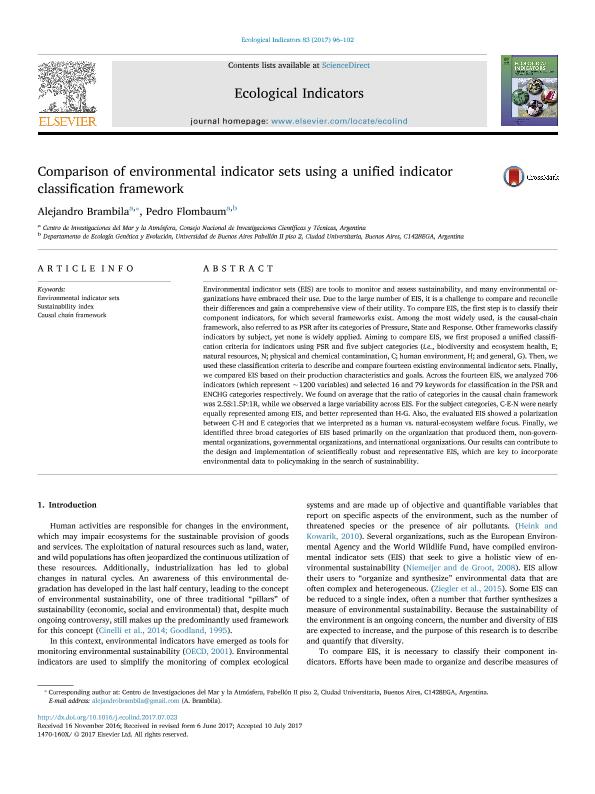Mostrar el registro sencillo del ítem
dc.contributor.author
Brambila, Alejandro

dc.contributor.author
Flombaum, Pedro

dc.date.available
2018-09-10T16:49:40Z
dc.date.issued
2017-12
dc.identifier.citation
Brambila, Alejandro; Flombaum, Pedro; Comparison of environmental indicator sets using a unified indicator classification framework; Elsevier Science; Ecological Indicators; 83; 12-2017; 96-102
dc.identifier.issn
1470-160X
dc.identifier.uri
http://hdl.handle.net/11336/58907
dc.description.abstract
Environmental indicator sets (EIS) are tools to monitor and assess sustainability, and many environmental organizations have embraced their use. Due to the large number of EIS, it is a challenge to compare and reconcile their differences and gain a comprehensive view of their utility. To compare EIS, the first step is to classify their component indicators, for which several frameworks exist. Among the most widely used, is the causal-chain framework, also referred to as PSR after its categories of Pressure, State and Response. Other frameworks classify indicators by subject, yet none is widely applied. Aiming to compare EIS, we first proposed a unified classification criteria for indicators using PSR and five subject categories (i.e., biodiversity and ecosystem health, E; natural resources, N; physical and chemical contamination, C; human environment, H; and general, G). Then, we used these classification criteria to describe and compare fourteen existing environmental indicator sets. Finally, we compared EIS based on their production characteristics and goals. Across the fourteen EIS, we analyzed 706 indicators (which represent ∼1200 variables) and selected 16 and 79 keywords for classification in the PSR and ENCHG categories respectively. We found on average that the ratio of categories in the causal chain framework was 2.5S:1.5P:1R, while we observed a large variability across EIS. For the subject categories, C-E-N were nearly equally represented among EIS, and better represented than H-G. Also, the evaluated EIS showed a polarization between C-H and E categories that we interpreted as a human vs. natural-ecosystem welfare focus. Finally, we identified three broad categories of EIS based primarily on the organization that produced them, non-governmental organizations, governmental organizations, and international organizations. Our results can contribute to the design and implementation of scientifically robust and representative EIS, which are key to incorporate environmental data to policymaking in the search of sustainability.
dc.format
application/pdf
dc.language.iso
eng
dc.publisher
Elsevier Science

dc.rights
info:eu-repo/semantics/openAccess
dc.rights.uri
https://creativecommons.org/licenses/by-nc-nd/2.5/ar/
dc.subject
Causal Chain Framework
dc.subject
Environmental Indicator Sets
dc.subject
Sustainability Index
dc.subject.classification
Meteorología y Ciencias Atmosféricas

dc.subject.classification
Ciencias de la Tierra y relacionadas con el Medio Ambiente

dc.subject.classification
CIENCIAS NATURALES Y EXACTAS

dc.title
Comparison of environmental indicator sets using a unified indicator classification framework
dc.type
info:eu-repo/semantics/article
dc.type
info:ar-repo/semantics/artículo
dc.type
info:eu-repo/semantics/publishedVersion
dc.date.updated
2018-09-07T13:50:19Z
dc.journal.volume
83
dc.journal.pagination
96-102
dc.journal.pais
Países Bajos

dc.journal.ciudad
Amsterdam
dc.description.fil
Fil: Brambila, Alejandro. Consejo Nacional de Investigaciones Científicas y Técnicas. Oficina de Coordinación Administrativa Ciudad Universitaria. Centro de Investigaciones del Mar y la Atmósfera. Universidad de Buenos Aires. Facultad de Ciencias Exactas y Naturales. Centro de Investigaciones del Mar y la Atmósfera; Argentina
dc.description.fil
Fil: Flombaum, Pedro. Consejo Nacional de Investigaciones Científicas y Técnicas. Oficina de Coordinación Administrativa Ciudad Universitaria. Centro de Investigaciones del Mar y la Atmósfera. Universidad de Buenos Aires. Facultad de Ciencias Exactas y Naturales. Centro de Investigaciones del Mar y la Atmósfera; Argentina. Universidad de Buenos Aires. Departamento de Ecología Genética y Evolución; Argentina
dc.journal.title
Ecological Indicators

dc.relation.alternativeid
info:eu-repo/semantics/altIdentifier/doi/https://dx.doi.org/10.1016/j.ecolind.2017.07.023
dc.relation.alternativeid
info:eu-repo/semantics/altIdentifier/url/https://www.sciencedirect.com/science/article/pii/S1470160X17304375
Archivos asociados
